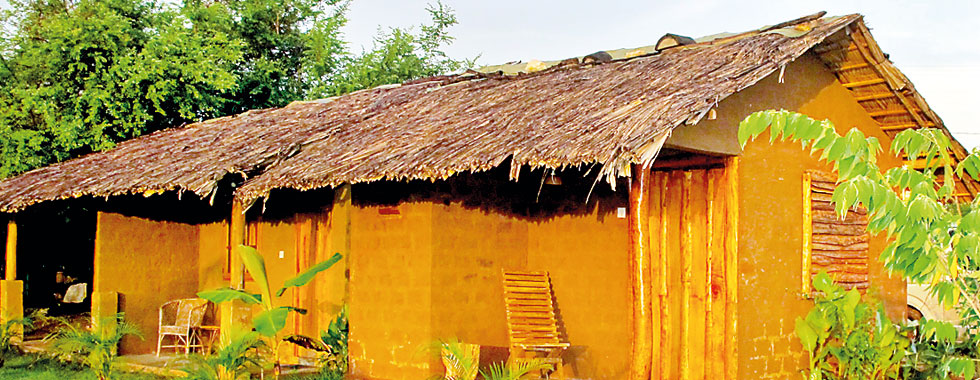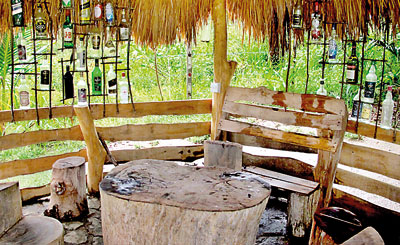Want a peacock wake up call?
View(s):In his search for unusual hotels to review for a new edition of the Bradt Guide to Sri Lanka, Royston Ellis discovers a rustic guesthouse near the Mattala Rajapaksa International Airport
A chorus of mewling peacocks greeted the dawn, and woke me up with a start. I gazed at the ceiling of the bedroom and found there was none, just the underside of the roof made with neatly thatched palmyra leaves.

Mud hut with all mod cons and inset, the lotus pond that gives the chalets its name
It took me a moment to realise that, as a result of wanting to inspect Sri Lanka’s newly opened second international airport, at Mattala in the deep south, I had checked in the night before to stay at what must be one of the most unusual near-airport hotels in the world.
The opening of the international airport – and the new cricket stadium – has created a demand for accommodation in the Hambantota area.Because there are no modern transit hotels open yet, I was lucky in discovering guest accommodation at Lotus Chalets.
Since it consists of only one stand-alone and two semi-detached huts sleeping two each, and one air-conditioned chalet for four, it isn’t really an airport hotel. But it’s close to the airport and, as such, it’s the perfect place for adventurous travellers to spend their first or last night in Sri Lanka. Guests fond of bird watching would want to stay longer.
Peacocks strutted along the country lane leading to the chena that has become the habitat of Lotus Chalets. There were more peacocks perched on branches in the surrounding woodland, screeching in surprise at our arrival. At nightfall, the enveloping sound of crickets chirping and frogs croaking filled the air like a jungle-movie sound track.
To camouflage their existence in the wilderness, the guest chalets, made of breezeblocks, have been plastered with mud and left unpainted. The roof is palmyra thatch, without asbestos or galvanised iron sheets. The air-conditioned chalet is concealed under a bushy passion fruit creeper, with its exterior walls covered in dried palm branches.

The jungle kiosk
There are no concrete paths, only mud trails, to the thicket of manioc bushes and furrows bright with the green leaves of sweet potatoes that is the kitchen garden, and to a small shack beside the road selling soft drinks and biscuits.
The garden furniture of tables and stools is made of unvarnished logs. There is an open-sided, reed-thatched kiosk beside a lotus pond where guests gather in the evening. A timber-framed watchtower looms above it and a mattress can be provided there for guests intent on sleeping in the open.
I stayed in one of the simple, mud-plastered chalets. It faces east with its own verandah, ideal for a cup of early morning tea as the sun rises and the peacocks bawl.
The room had a desk, power point for laptop (3G service is available), a stand fan, a sturdy locally made wooden bed and a comfortable mattress, bed sheet and towel. The interior walls were plastered with mud and the floor was unadorned cement; no boutique hotel refinements here.
There was no ceiling, only the intricate pattern of the palmyra palm leaf roof. The attached bathroom with tiled floor was as long as the bedroom and had walls daubed with jungle green splodges.
For meals, there is a small kitchen where vegetables from the farm are used for delicious curries, prepared on request and presented for self-service from a side counter in the dining pavilion where a television hangs. A western breakfast option is available.
I can imagine guests used to slick, airport hotels being utterly bemused by Lotus Chalets. While I stayed there for convenience – it is about 15 minutes drive from the airport and only five minutes from the cricket stadium – I was enchanted with its simple, rural charm.
Lotus Chalets is isolated at present, which is part of its appeal for nature lovers or those tired of the city. It’s easy to reach by following the new dual carriage highway from Hambantota, passing the airport turn-off and continuing to Sooriyawewa. There are signs indicating the direction down lanes around the cricket stadium to find this basic haven. It may be deep in the wildness but it’s so near to the rest of the world by flights from the brand new airport.
Lotus Chalet, Canal Road, Migahajandura, Sooriyawewa; tel: 077 7352450; lotuschalets@gmail.com; www.lotuschalets.com. Rates from US$38 double, room only.
Follow @timesonlinelk
comments powered by Disqus


